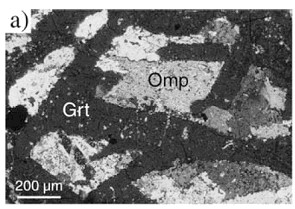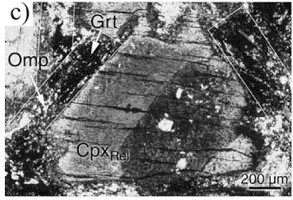 Web Content Display Web Content Display
Eclogitization by fluid infiltrationINTRODUCTIONThe metamorphic transformation of the subducting slab governs several large-scale processes related to subduction zones. Devolatilisation of the slab triggers arc magmatism and the increasing density due to eclogitization of the oceanic crust forces the lithospheric subsidence by slab pull. Rocks of the upper oceanic crust usually experience transformation into volatile-rich blueschists and subsequently into eclogites during burial. In contrast, the gabbroic part of the lower oceanic crust may transform directly to eclogites without intervening mineral reactions, as indicated by seismological and petrological data (e.g. Hacker 1996). Kirby et al. (1996), for example, explain intermediate depth earthquakes (50-170 km) in subduction zones with the volume reduction that accompanies the direct transformation from gabbro to eclogite. Within dry, coarse-grained rocks, high-pressure mineral assemblages are sometimes formed only within fluid veins or in deformed domains. In such rocks, low-pressure minerals can persist metastably under conditions well above their equilibrium boundaries if no catalyst such as a fluid triggers metamorphic reactions (e.g. Austrheim 1986; Rubie 1998; Austrheim 1998). Hence, fluid pressure and fluid composition, in addition to the P-T conditions, are crucial factors that control the transformation of gabbroic protoliths into eclogites (Vrana et al. (1975). The Precambrian eclogites and gabbros of central Zambia provide an exceptional opportunity to study the fate of subducting oceanic gabbroic rocks. Using textural and mineral chemical data, we deduce and document the important role of a fluid phase as a catalyst for eclogitization. PETROLOGYUndeformed eclogites preserve features of a former gabbroic texture, reflected by replacements of plagioclase and magmatic pyroxene by eclogite facies minerals (garnet and omphacite) (Fig. 1). Relics of magmatic pyroxene are common and may even preserve magmatic twinning. No evidence for prograde blueschist or amphibolite facies mineral assemblages was found in the eclogites. In contrast, the fine-grained intergrowth of omphacite, garnet, kyanite, and quartz, which replace former plagioclase (Fig. 1) indicate that eclogitization might have affected the gabbroic protoliths directly without any significant intervening metamorphic reactions. Eclogitization took place under P-T conditions of 630-690°C and 26-28 kbar, suggesting a large overstepping (> 10 kbar) of reaction boundaries.
Fig. 1: Textures in eclogites: a) Preserved gabbroic texture with garnet pseudomorphs after plagioclase (dark) and omphacite replacing magmatic pyroxenes (bright); c) Preserved magmatic twinning in a relic of a magmatic pyroxene. Plagioclase laths have been replaced by fine-grained garnet (dark) + omphacite (bright) + quartz + kyanite intergrowths (from John and Schenk 2003).
Fig. 2: Veins in eclogite: a) Vein consisting of large, subhedral omphacite and apatite crystals. The surrounding matrix consists of fine-grained garnet and omphacite replacing the former magmatic texture. b) Vein consisting of kyanite and omphacite with preserved growth zoning (from John & Schenk 2003) FLUID INFILTRATIONEclogitization was initialized and accompanied by channelised fluid flow resulting in veins with large, subhedral grains of omphacite, kyanite and garnet (Fig. 2). The preservation of the undeformed, gabbroic textures in eclogites must be the consequence of pure fluid-rock interaction. The mineral reactions that transformed the gabbros into eclogites operated via dissolution of the reactant(s), material transport and precipitation of the product(s). The degree of eclogitization was related to the fluid/rock ratio rather than the degree of ductile deformation. CONCLUSIONSThe features described in the eclogites imply the presence of a free fluid phase during the gabbro-to-eclogite transformation. The fluid allowed the necessary transport of material fort he dissolution-precipitation mechanism that characterizes the metamorphic mineral replacements. Eclogitization was limited by reaction kinetics rather than by metamorphic P-T conditions. Even though equilibrium phase boundaries were overstepped, the infiltration of fluids was necessary for triggering the gabbro-to-eclogite transformation, and fluid availability is the key factor for governing the gabbro-to-eclogite transformation. |
 Events Events
Kieler Wissenschaftler fühlen den 'Puls der Erde' Wie funktioniert die Recyclingmaschine der Erde?Nach elf Jahren endet der Kieler Sonderforschungsbereich 574 zu Subduktionszonen Final colloquium of SFB 574 Teilprojekt ÖffentlichkeitsarbeitMEERESFORSCHUNG FÜR MICH UND DICH |
|
©SFB574 // Wischhofstrasse 1-3 // D-24148 Kiel // T. +49 (0)431 600 1413 // elange [AT] geomar.de








